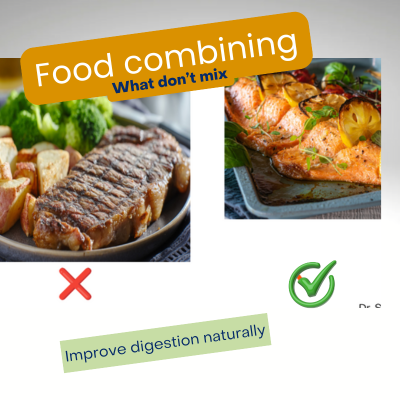
⚖️ The Science Behind Food Combining
Our stomach uses different digestive environments for different foods.
- Proteins require an acidic environment.
- Starches require a more alkaline one.
When we eat them together — like meat and potatoes — the stomach must compromise. The result? Neither food digests fully. Fermentation begins, gas builds up, and we feel sluggish or uncomfortable.
Over time, this fermentation can burden the liver and intestinal lining, creating low-grade inflammation.
In contrast, simpler combinations allow your body to release the right enzymes in the right sequence. Nutrients are better absorbed, the gut stays calm, and post-meal energy remains steady.
Poor Combinations → Gas • Bloating • Fatigue
Proper Combinations → Lightness • Clarity • Better Absorption
🕉️ Rooted in Ancient Wisdom & Modern Physiology
Ayurveda teaches that every food carries unique properties — virya (its energy) and vipaka (its post-digestive effect). Combining incompatible foods disturbs Agni, the digestive fire.
Modern nutrition mirrors this insight through the lens of enzymes and pH balance.
Both agree: harmonious combinations reduce digestive stress and support vitality.
🍽️ The Laws of Food Combining
Here are simple guidelines you can start using right away:
- Proteins and Starches Don’t Mix
- Avoid pairings like steak + potatoes, chicken + rice, or beans + bread.
- Instead, combine proteins with non-starchy vegetables such as leafy greens or zucchini.
- Fruits Are Best Eaten Alone
- Fruits digest quickly; eating them after heavy meals leads to fermentation.
- Best time: on an empty stomach, about 30 minutes before other foods.
- Avoid Mixing Acidic and Sweet Fruits
- Oranges + bananas create digestive conflict.
- Instead, pair within the same family — apples + pears or oranges + pineapple.
- Melons Should Be Eaten Alone
- “Eat it alone or leave it alone.” Melons digest very fast and clash with most foods.
- Vegetables Combine Well with Most Foods
- Non-starchy veggies (greens, cucumbers, zucchini) go well with proteins or starches.
- Example: Fish + vegetables + lemon is a great combination, while steak + potatoes + fruit dessert is not.
When we choose food combinations that work with our biology — not against it — every meal becomes gentle medicine.
⏱️ The Sequence of Eating Matters
The order in which we eat foods can dramatically influence digestion and nutrient absorption.
Foods differ in density, fiber, fat, and protein content — all of which determine how long they stay in the stomach.
- Liquids and Juices: Absorbed almost immediately; great to start with.
- Fresh Non-Starchy Fruits: Light and hydrating; digest in 30–60 minutes.
- Smoothies: Technically solid food; treat as a meal, not a drink.
- Vegetables: Green leafy vegetables digest faster than starchy ones. Lightly steamed broccoli, zucchini, or spinach move through easily, while potatoes or squash take about 2 hours.
- Beans & Grains: More complex; take 2½–3 hours to digest.
- Nuts & Seeds: Dense and rich in fat and protein; require 2–3 hours. Eat small portions and chew thoroughly.
- Animal Proteins & Dairy: Most complex; combine only with vegetables. Avoid mixing multiple proteins (e.g., eggs + cheese + meat).
Deep-fried or heavily processed foods are the most difficult to digest — not only because of fat content but also because high heat alters oil molecules, creating toxins that strain the liver.
Simplify your plate. The more variety you pile on, the more you burden your gut.
🌞 A Day of Easy Digestion
Here’s how a simple, well-combined day might look:
Morning: Warm lemon water → fruit bowl (pineapple + kiwi or apple + pear)
Lunch: Mixed greens + lentil stew + steamed vegetables
Snack: Green juice or a handful of soaked nuts
Dinner: Steamed veggies + quinoa + baked fish with lemon
💚 Three Supportive Food Habits for Better Digestion
1️⃣ Quantity — Leave Room to Digest
Fill your stomach one-third with food, one-third with liquid, and leave one-third empty.
Overeating, even healthy food, slows enzyme activity and can lead to reflux. Stop eating when you feel about 75–80% satisfied.
“Leave the table feeling light, not loaded.”
2️⃣ Regularity — Eat with Rhythm
Your digestive system thrives on consistency. Eat at similar times daily and space meals 4–5 hours apart to allow your gut to complete its cleaning cycle (the migrating motor complex).
Make lunch your largest meal and dinner lighter and earlier.
“Rhythm in meals creates rhythm in metabolism.”
3️⃣ Conscious Eating — Eat with Awareness
Digestion begins in the mind and mouth. Take a deep breath before eating, chew thoroughly, and avoid distractions.
A brief moment of gratitude before your meal activates the “rest-and-digest” mode and helps your body truly receive nourishment.
“When you eat with presence, your body receives it as nourishment, not stress.”
🌿 Putting It All Together
The ideal meal, in terms of digestion, consists of one food group or one family of foods — like apples and pears, or salad greens mixed with sprouts and herbs.
When foods of similar texture, water content, and digestibility flow together, digestion is faster, cleaner, and more efficient.
Healthy digestion is not about restriction — it’s about alignment with your body’s natural chemistry and rhythm.
Even small changes — simplifying your meals, eating in peace, and leaving space in your stomach — can lead to profound improvements in energy, mood, and gut comfort.
✨ Key Takeaways
- Combine foods that digest at similar speeds.
- Avoid pairing proteins and starches in the same meal.
- Eat fruit alone, especially melons.
- Eat small portions and chew thoroughly.
- Maintain 4–5 hours between meals and eat at regular times.
- Don’t eat when stressed or distracted.
Healthy digestion = better energy, clearer mind, and vibrant health.
References & Further Reading
Meyerowitz S. Food Combining and Digestion. Sproutman Publications, 2002.
Lad V. Ayurveda: The Science of Self-Healing. Lotus Press, 1984.
Guyton AC, Hall JE. Textbook of Medical Physiology. Elsevier, 2020.
NIDDK. “Your Digestive System & How It Works.” (2023).
Harvard Health Blog. “Mindful Eating and Digestive Health.” (2022).


